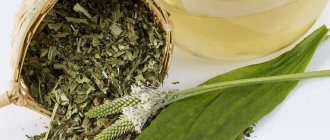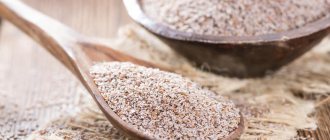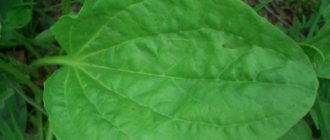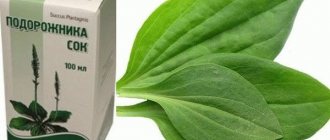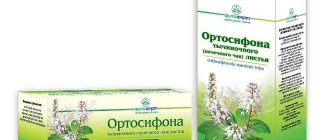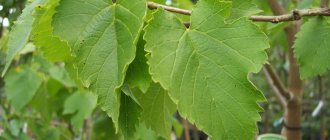Manufacturer: Natur Produkt Europe BV
Active ingredients
- Not indicated. See instructions
Pharmacological action
- Not indicated. See instructions
- Description of the pharmacological action of Terra-Plant Plantain
- Composition of Terra-Plant Plantain
- Indications for use of the drug Terra-Plant Plantain
- Release form of the drug Terra-Plant Plantain
- Contraindications to the use of the drug Terra-Plant Plantain
- Method of administration and dosage of the drug Terra-Plant Plantain
- Precautions when taking Terra-Plant Plantain
- Storage conditions for the drug Terra-Plant Plantain
- Shelf life of the drug Terra-Plant Plantain
Description of pharmacological action
Plantain has anti-inflammatory, wound-healing, antitussive and expectorant effects. Plantain raw materials contain: mucus (2-6%), flavonoids, iridoids (2-3%), caffeic acid derivatives, tannins, traces of saponins. Plantain is used as an expectorant for bronchitis, laryngitis, bronchial asthma, acute respiratory diseases, and is effective for inflammatory diseases of the mouth and throat, gastric ulcers, liver diseases, enteritis and colitis. Traditional medicine actively uses plantain for various diseases of the respiratory organs with the release of mucous sputum, chronic bronchitis, tracheitis, asthma, and cough. Mint has long been used as a digestive aid and is used to relieve intestinal spasms and nausea. Peppermint oil has antibacterial, antispasmodic and carminative effects. In this regard, its use is officially recommended for colds, coughs, bronchitis, inflammation of the oral mucosa and throat, gastrointestinal discomfort, pain and spasms in the liver and gallbladder.
Large plantain
07/01/2019 Large plantain (lat. Plantago major
) is a perennial herbaceous plant with a rosette of basal leaves.
Modern botanists identify more than 150 species of plantain. They grow mainly in temperate and subtropical zones of Eurasia, on the African continent, and in the countries of North and South America.
This plant has many popular nicknames, the most popular of which are Babka, Roadburdock, Traveler, Semizhilnik, Poputnik, Triputnik, Dorozhnik, Rannik, Poreznik, Chiryevaya grass.
Great plantain has become widespread in Ukraine and Belarus and, despite the unique medicinal properties of the plant, is classified as a harmful weed.
It can most often be found in clearings and forest edges, in flooded meadows, wastelands, in the steppes, along roads (hence the name plantain), in gardens, and off the shores of freshwater bodies of water.
Plantain seeds become sticky when wet, so they can easily be carried along with shoes, and then germinate along the side of roads and paths. For this ability, the plant received the nickname “white man’s trace” among the American aborigines.
In Ukraine, large plantain is purposefully grown by individual farms, although in small volumes (up to 2 tons of medicinal raw materials). It grows well in all types of soil, but a good harvest can only be obtained on fertile soils with sufficient moisture.
Description of the plant
The root of the large plantain is vertical, thick, short, with numerous fibrous thread-like roots.
The basal leaves are entire, large, with long petioles, ovate and lanceolate. They clearly show relief longitudinal arcuate veins, the number of which can range from 3 to 9.
The peduncle of plantain is an erect, thick cylindrical spike, reaching from 15 to 30 centimeters in height. One plant can have several flower-bearing arrows.
The flowers are small, inexpressive, with a green four-part calyx and a brownish corolla.
The fruit is a multi-seeded, two-locular capsule containing from 6 to 30 grayish-brown achenes.
Pollination of plantain occurs with the help of wind.
It blooms from the second ten days of May until September inclusive. The seeds ripen at the end of August and September. Moreover, one plant can produce up to 15,000 seeds!
Plantain seedlings are usually very small and easily die with a lack of moisture and an abundance of weeds. At the beginning of the growing season, the plant forms a rosette of leaves pressed to the surface of the ground, and then throws out one or more flowering shoots, which can subsequently reach 50 centimeters in height.
Composition and medicinal properties
Great plantain is considered a storehouse of useful substances, and the healing properties of the plant have been known for at least a thousand years.
Plantain leaves contain up to 20% pectin substances, a large number of vitamins (groups A, K and C), organic acids (benzoic, salicylic, lilac, vanilla, chlorogenic, neochlorogenic, caffeic and others), steroids, flavonoids, saponins, tannic and bitter substances, polysaccharides, many macro and microelements. Thanks to this unique set, plantain is a valuable medicinal plant.
Plantain leaves have an analgesic, wound-healing, disinfectant, hemostatic and anti-inflammatory effect.
Plantain extract has a sedative and hypotensive effect, and the presence of phytoncides in the plant determines its antimicrobial effect.
Infusions and decoctions from the leaves have an antiallergic effect, improve the secretory function of the gastrointestinal tract, stimulate the secretion of gastric juice and increase its acidity, and enhance the secretion of the bronchial glands.
Plantain infusion is also used as an adjuvant in the treatment of tuberculosis, whooping cough, bronchitis, chronic gastritis, stomach and duodenal ulcers.
Plantain is included in many herbal teas, from which cough tea is subsequently prepared. This drink has a calming effect and is also used as an enveloping, emollient and expectorant.
Fresh crushed plantain leaves are usually applied to wounds, abscesses, bruises, and burns. They are also used against acne, boils, ulcers, rashes and insect bites.
When the eyes are inflamed, plantain infusion is used to wash them.
The ability of the plant to lower cholesterol levels in the body and reduce the prevalence of aortic atheromatosis has also been revealed.
Plantain can also be used as a moisturizer for skin and hair care, and to get rid of cracks and abrasions on the feet, medicinal baths and compresses for calluses are prepared from the infusion.
Harvesting the plant
The collection and preparation of plantain leaves should be done at the time of its flowering (from May to August). They are plucked by hand or cut with a sickle (it is advisable not to damage the rosette of the plant).
It is not recommended to collect plantain near highways and railways, as well as near industrial buildings, since this plant perfectly adsorbs toxins and harmful substances.
Collected leaves must be clean, healthy, without signs of disease or insect damage.
Dry the plantain by spreading it in a thin layer in the sun or in a well-ventilated dry room, constantly turning it over. The leaves are dried until the leaves appear brownish-green. Drying is stopped as soon as the leaf petioles become brittle.
Having completed the drying process, it is advisable to sort out the raw materials again in order to remove all yellowed leaves, flower-bearing arrows and other impurities.
It is best to store dried herbs in glass containers, paper bags or canvas bags.
Ways to control weeds
Post-emergence herbicides are commonly used to control plantain.
In small areas, weed control is carried out using conventional hand weeding.
A good effect is demonstrated by preliminary mulching of the beds. As mulch, you can use darkened plastic film, sawdust, peat, compost, and other natural materials.
Indications for use
Terra-Plant Plantain is a natural complex product containing a whole range of biologically active substances necessary for colds and inflammatory processes, while also having a beneficial effect on the digestive system. Terra-Plant Plantain is especially suitable for those who want to protect themselves from coughs and colds or alleviate infectious and inflammatory processes in the mouth and throat. The product is recommended by the Institute of Nutrition of the Russian Academy of Medical Sciences as a mild expectorant for seasonal colds.
Medicinal recipes from plantain
Recipe for an infusion of plantain leaves for the treatment of gastritis : pour 3 teaspoons of dry leaves with a glass of boiling water, let it brew for 6 - 8 hours. Take 1/3 cup 3 times a day 30 minutes before meals. Decoction of plantain seeds for the treatment of gastritis: 20g. seeds, pour 200 ml of water and leave in a thermos overnight. Take 2 tbsp. spoons 3 times a day. For enteritis and acute and chronic colitis, plantain juice is used for treatment, 1 tbsp orally. spoon 3 times a day 15 minutes before meals. The course of treatment is 30 days. A decoction of plantain leaves is used to treat stomach and duodenal ulcers . 6 – 7 pcs. fresh leaves or 2 tbsp. Brew dry spoons with a glass of boiling water. After 30 minutes, strain. Take ¼ cup in the morning and evening on an empty stomach and 1 tbsp. spoon 6 – 7 times a day. Also, for the treatment of stomach and duodenal ulcers, for colitis, as an anti-inflammatory and enveloping agent, and to soothe pain during an exacerbation of a peptic ulcer, a decoction of plantain seeds is used. For this, 1 tbsp. Pour a spoonful of seeds into ½ cup of boiling water and let it brew for 30 minutes. Take 2 tbsp. spoon 3 times a day 30 minutes before meals. A decoction of plantain leaves is used as an expectorant for cold coughs , as well as for the treatment of whooping cough, asthma, pleurisy and chronic catarrh of the upper respiratory tract and bronchi. 1 tbsp. Pour a glass of boiling water over a spoonful of crushed leaves, cover and let it brew for 1 hour, strain. Take 2 tbsp. spoons 3 – 4 times a day. This decoction also helps with bedwetting and kidney disease. A decoction of plantain seeds is used to treat cystitis : 2 tbsp. Pour a glass of boiling water over spoons of seeds, leave until cool, strain. Take mucus 1 tbsp. spoon on an empty stomach 3 – 5 times a day. An infusion of plantain leaves is used to treat cholecystitis . 1 tbsp. Pour 200 ml of boiling water over a spoonful of leaves, cover with a lid and leave for 10 minutes. Strain the infusion and drink in small sips within an hour. The course of treatment is 3 weeks. Plantain juice mixed with honey has an antisclerotic effect . Pass well-washed plantain leaves through a meat grinder and squeeze out the juice. Mix the juice with honey in equal proportions and cook in a water bath for 10 minutes. Take 2 - 3 tbsp. spoons a day. Psyllium seeds are used as a laxative . Seeds are consumed whole or crushed, 1 tbsp. spoon at night or in the morning before meals, with plenty of water. Before eating, scald the seeds with boiling water and quickly drain the water (so as not to lose the mucilage). You can do it differently: brew 1 tbsp. spoon of seeds ½ cup of boiling water, let cool and drink along with the seeds. The effect occurs within 5 – 12 hours. A decoction of plantain seeds is used to treat menopause in women. 1 tbsp. Pour a glass of boiling water over a spoonful of seeds and leave in a water bath for no more than 5 minutes. Cool and strain. Take 2 tbsp. spoons 4 times a day.
Best before date
36 months
Vitamins with similar effects
- Maxiflorum with Valerian (Oral tablets)
- Incas gold. Men's Formula (Oral Tablets)
- Encaps (Capsule)
- Influence (Capsule)
- Set of herbs No. 4 (Oral tablets)
- Narosan Orange (Oral liquid)
- Marine calcium for children with iron (Oral tablets)
- Marine calcium for children with manganese (Oral tablets)
- Pankramin (Powder for oral solution)
- Pantohematogen "Altamar™-1" (Capsule)
The description of the Terra-Plant vitamin is intended for informational purposes only. Before starting to use any drug, it is recommended to consult a doctor and read the instructions for use. For more complete information, please refer to the manufacturer's instructions. Do not self-medicate; EUROLAB is not responsible for the consequences caused by the use of information posted on the portal. Any information on the project does not replace consultation with a specialist and cannot be a guarantee of the positive effect of the drug you use. The opinions of EUROLAB portal users may not coincide with the opinions of the site Administration.
Are you interested in the Terra-Plant vitamin? Do you want to know more detailed information or do you need a doctor's examination? Or do you need an inspection? You can make an appointment with a doctor - the Euro lab is always at your service! The best doctors will examine you, advise you, provide the necessary assistance and make a diagnosis. You can also call a doctor at home . Euro lab clinic is open for you around the clock.
Attention! The information presented in the vitamins and dietary supplements section is intended for informational purposes and should not be a basis for self-medication. Some of the drugs have a number of contraindications. Patients need to consult a specialist!
If you are interested in any other vitamins, vitamin-mineral complexes or dietary supplements, their descriptions and instructions for use, their analogues, information about the composition and form of release, indications for use and side effects, methods of use, dosages and contraindications, notes about the prescription of the drug for children, newborns and pregnant women, price and consumer reviews, or you have any other questions and suggestions - write to us, we will definitely try to help you.
